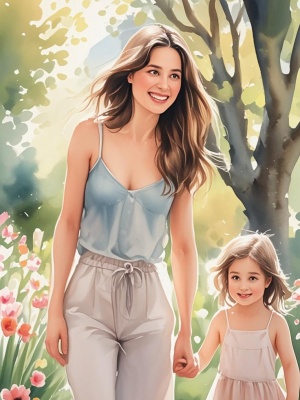The Art of Creating Watercolor Portraits from Photos
Watercolor portraits from photos have become increasingly popular among artists and art enthusiasts alike. This unique art form combines the precision of photography with the expressive beauty of watercolor painting, resulting in stunning, one-of-a-kind artworks. Whether you're a professional artist or a beginner looking to explore this medium, creating watercolor portraits from photos offers endless creative possibilities.
Why Choose Watercolor Portraits from Photos?
Watercolor portraits from photos provide several advantages over traditional portrait painting. First, they allow artists to work from a stable reference point, ensuring accurate proportions and likeness. Second, the photo serves as a guide for capturing subtle details that might be missed in live sessions. For those interested in exploring different artistic styles, our AI Painting Guide offers valuable insights into digital art techniques.
Key Benefits:
- Preserves precious memories in an artistic format
- Allows for creative interpretation of the original photo
- More accessible than live portrait sessions
- Can be created at any pace without time constraints
Essential Techniques for Watercolor Portraits
Creating successful watercolor portraits from photos requires mastering specific techniques. The transparent nature of watercolors demands careful planning and execution. According to experts at Handprint, a renowned watercolor resource, understanding color theory and water control is crucial for portrait work.
Problem-Solution Matrix
-
Problem: Maintaining likeness while adding artistic interpretation
Solution: Start with light pencil sketches, focusing on key facial features
-
Problem: Controlling watercolor bleeding
Solution: Use quality paper (140lb or heavier) and practice wet-on-dry techniques
-
Problem: Achieving skin tone accuracy
Solution: Mix primary colors rather than using pre-mixed flesh tones
Choosing the Right Photo Reference
Not all photos work equally well for watercolor portraits. The ideal reference photo should have:
- Clear, well-defined facial features
- Good contrast between light and shadow
- A resolution high enough to see details
- Natural lighting without harsh shadows
For those working with less-than-ideal photos, our Photo Enhancer tool can help improve image quality before beginning your watercolor portrait.
Digital vs. Traditional Watercolor Techniques
With advancements in digital art tools, artists now have two approaches to creating watercolor portraits from photos:
Traditional Watercolor
Using physical paints and paper offers authentic texture and unpredictable watercolor effects that many artists cherish. The tactile experience of traditional watercolor painting can't be replicated digitally.
Digital Watercolor
Digital tools like Photoshop or Procreate provide more control and the ability to undo mistakes. Many apps now simulate realistic watercolor effects, as discussed in our AI Art Guide.

Conclusion: The Timeless Appeal of Watercolor Portraits
Watercolor portraits from photos represent a beautiful marriage of technology and traditional artistry. Whether created digitally or with physical paints, these portraits capture the essence of their subjects while showcasing the artist's unique style. For more inspiration, visit our Gallery to see examples of stunning watercolor portrait transformations.

As you embark on your watercolor portrait journey, remember that practice and patience are key. Each portrait you create will bring you closer to mastering this rewarding art form. For additional resources on portrait techniques, the Artist's Network offers excellent tutorials and workshops.